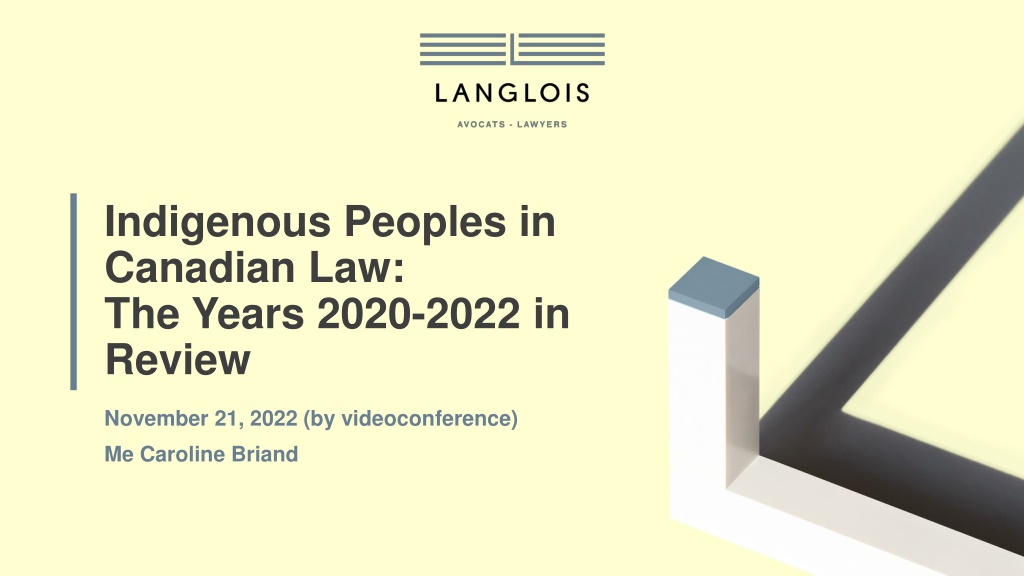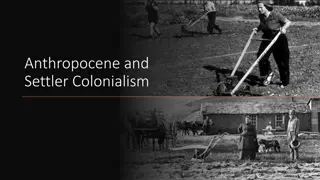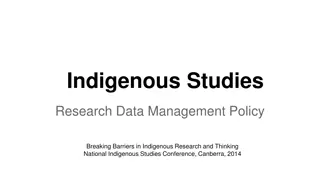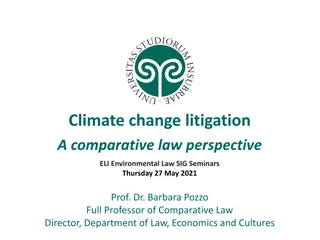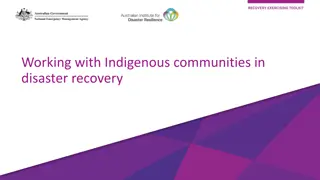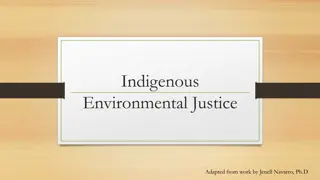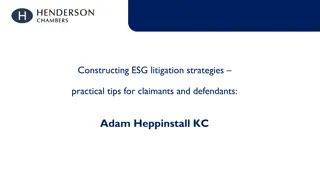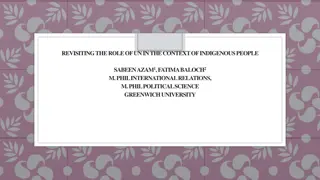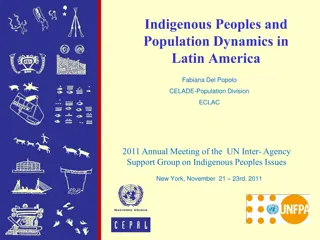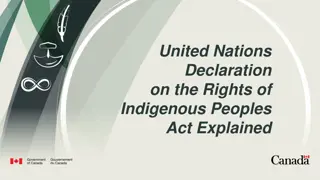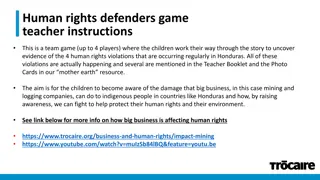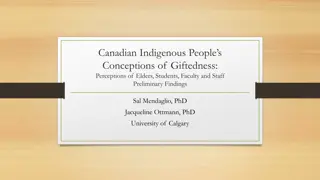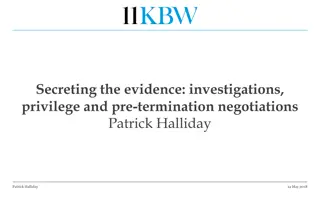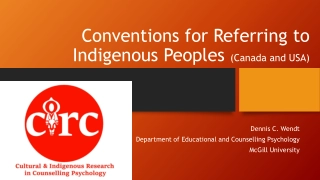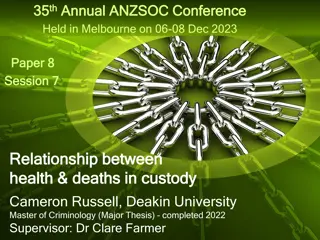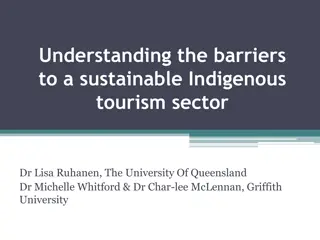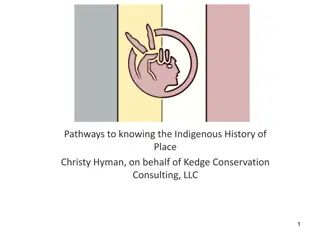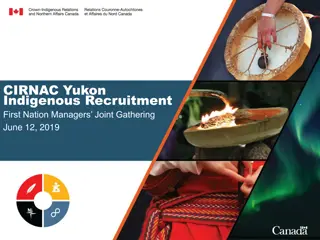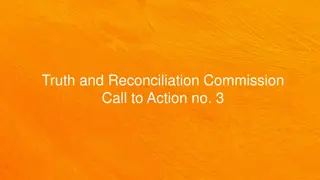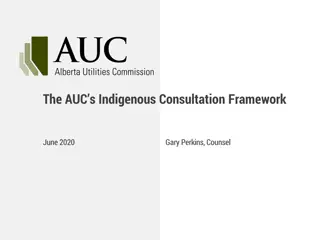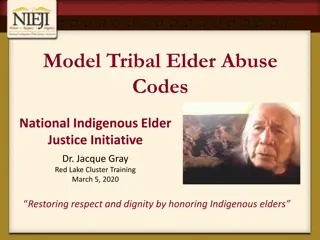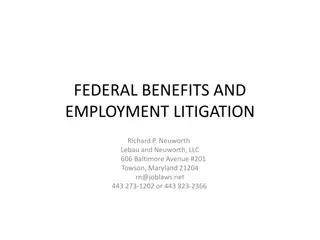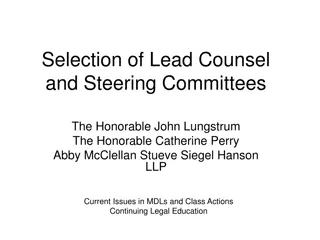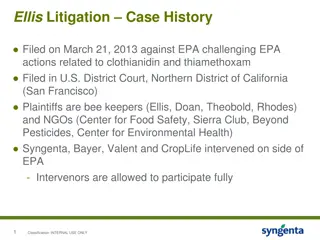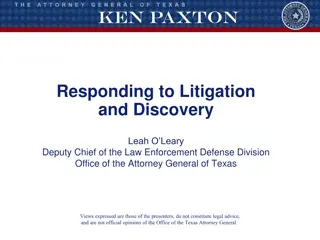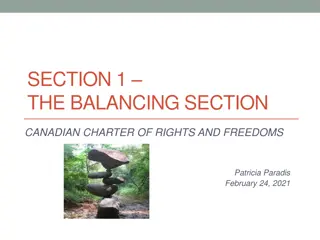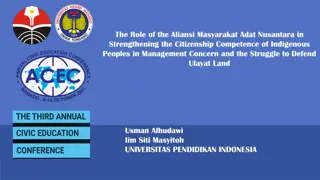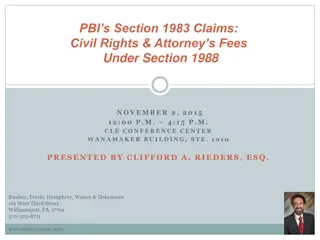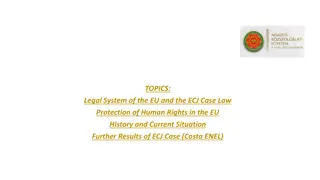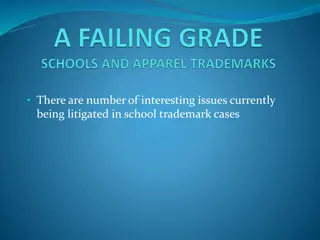Indigenous Rights Litigation in Canadian Law: A Review of 2020-2022
Strategic considerations in Indigenous rights litigation, social acceptability in decision-making, Indigenous identities, and future expectations were discussed in a review from November 21, 2022. The case of Southwind v. Canada highlighted issues of fiduciary obligations and equitable compensation for the Lac Seul First Nation. Important legal precedents and key decisions were examined within the context of colonial borders and Indigenous perspectives.
Uploaded on Oct 01, 2024 | 0 Views
Download Presentation

Please find below an Image/Link to download the presentation.
The content on the website is provided AS IS for your information and personal use only. It may not be sold, licensed, or shared on other websites without obtaining consent from the author. Download presentation by click this link. If you encounter any issues during the download, it is possible that the publisher has removed the file from their server.
E N D
Presentation Transcript
Indigenous Peoples in Canadian Law: The Years 2020-2022 in Review November 21, 2022 (by videoconference) Me Caroline Briand
Contents 1. Introduction 2. Strategic considerations in Indigenous rights litigation 3. Social acceptability and Indigenous perspectives in decision- making 4. Indigenous identities and colonial borders 5. What to expect in the next 12 months? 6. Conclusion / Questions?
1. Introduction What s new? A new framework for judicial review: Canada (Minister of Citizenship and Immigration) v. Vavilov, 2019 SCC 65 A global pandemic later Climate / economic crisis
2. Strategic considerations in Indigenous rights litigation Assessment of equitable compensation: Southwind v. Canada, 2021 SCC 28 Facts: - - The Lac Seul First Nation is a Treaty 3 First Nation in Northern Ontario Development of a dam and reservoir by Canada 1/5 of the FN s reserve land was flooded and the members were deprived of fertile land Under the Indian Act (as it existed at the time), expropriation of lands reserved by the Crown for Indigenous people (and protected by the 1763 Royal Proclamation) was permitted for public works 1985: The FN submitted a specific claim to the Specific Claims Branch 1991: The FN filed a civil claim in the Federal Court 2016: 50 day trial (24 witnesses, 22 experts) - - - -
2. Strategic considerations in Indigenous rights litigation Southwind v. Canada (cont d) Issues: - What is the nature of Canada s fiduciary obligations towards the FN? - Principles for assessment of equitable compensation
2. Strategic considerations in Indigenous rights litigation Southwind v. Canada (cont d) Previous decisions: Federal Court: - Canada owed a fiduciary duty to the FN - Canada found to be in breach of all of its fiduciary obligations to the FN - Appropriate remedy = Equitable compensation Awarded a total of $30M in damages to the FN FCA (2-1 decision): No palpable and overriding errors
2. Strategic considerations in Indigenous rights litigation Southwind v. Canada (cont d) Majority (Karakatsanis J.) Canada s fiduciary duty to Indigenous people: o The specific nature of Canada s fiduciary duty to Indigenous Peoples, especially over reserve land, and the principle of honourable dealing, inform courts on how to assess equitable compensation o Goal: Reconciliation o Fiduciary duty in a case involving land requires loyalty, good faith, full disclosure and, where reserve land is involved, the protection of the First Nation s quasi-proprietary interest from exploitation (para 64)
2. Strategic considerations in Indigenous rights litigation Southwind v. Canada (cont d) Majority (Karakatsanis J.) Principles of Equitable Compensation: o Defining the fiduciary relationship: Though a fiduciary relationship is different than a traditional trust relationship, breach of that relationship is akin to breach of a trust relationship (para 67). Its main aim is to restore the actual value of the thing lost through the fiduciary relationship (para 69). o Causation: The fiduciary breach must have caused the FN s lost opportunity (para 70). Equity compensates the plaintiff not only for the actual loss but also for the loss of opportunity. The majority is also careful to remind us that foreseeability does not apply in the assessment of the breach of fiduciary duty. o Equitable Presumptions: Equity presumes that the FN would have made the most favourable (or profitable) use of the property. Courts must assess the FN s loss of opportunity.
2. Strategic considerations in Indigenous rights litigation Southwind v. Canada (cont d) Majority (Karakatsanis J.) Application - TJ s main error was to use the principles of expropriation law rather than that of fiduciary duties to determine the extent of the compensation - Value of the loss: Instead of applying a hypothetical revenue-sharing agreement that the parties could have agreed upon, the majority turns to principles of equitable compensation as outlined before. The FN was entitled to compensation for: o The lost opportunity to negotiate a peaceful surrender o The value of the flooded land in 1929 - The case is sent back to the FC for reassessment of the equitable compensation
2. Strategic considerations in Indigenous rights litigation Southwind v. Canada (cont d) Dissent (C t J.) - The majority focused on a general loss of opportunity to negotiate rather than the loss of opportunity to claim value from the hydroelectricity produced - TJ did not commit any reviewable error. Entitled to general deference on appeal given the length of the trial
2. Strategic considerations in Indigenous rights litigation Advanced Costs: Anderson v. Alberta, 2022 SCC 6 Facts: - Beaver Lake Cree Nation applies for advanced costs to fund its litigation under s. 35 of the 1982 Constitution. - The case is originally a land claim by the Beaver Lake Cree nation alleging that the Crown allowed traditional lands to be taken up for industrial or resource development purposes (para 9).
2. Strategic considerations in Indigenous rights litigation Anderson v. Alberta (cont d) Previous decisions: - The case management judge stated that the case had public importance (para 11) relying on Okanagan and Little Sisters Books and art Emporium v Canada - On the factor of impecuniosity, the judge found that the FNhad many pressing needs and could not fund the litigation throughout and thus awarded advanced costs (para 13) - Overturned by the ABCA
2. Strategic considerations in Indigenous rights litigation Anderson v. Alberta (cont d) Issue: Must a Nation that has access to resources in the form of assets and income necessarily use / exhaust those resources to fund litigation, where those resources would otherwise be used to fund other priorities?
2. Strategic considerations in Indigenous rights litigation Anderson v. Alberta (cont d) Issue: Must a FN that has access to resources in the form of assets and income necessarily use / exhaust those resources to fund litigation, where those resources would otherwise be used to fund other priorities?
2. Strategic considerations in Indigenous rights litigation Anderson v. Alberta (cont d) Decision: - In a unanimous decision (by Karakatsanis and Brown JJ), the Court sides with Canada and Alberta and overturns the decision by the case management judge. - After a brief overview of the guiding principles of discretion (in awarding advanced costs) and the imperatives of reconciliation, the Court (paras 19-27). - In the context of advanced costs test and assessing the impecuniosity requirement, courts must take judicial notice of colonialism and its impacts, insofar as they may be relevant to understanding a First Nation government s financial situation and spending priorities (para. 36)
2. Strategic considerations in Indigenous rights litigation Anderson v. Alberta (cont d) Decision (cont d): - The impecuniosity requirement must look beyond the First Nation s government s financial resources in the abstract (para 32). - Test for impecuniosity: We are therefore content to affirm that an applicant genuinely cannot afford to pay for the litigation where, and only where, it cannot meet its pressing needs while also funding the litigation. And, as we explain further below, where the applicant is a First Nation government, pressing needs must be understood from the perspective of the First Nation government. (para 40, emphasis added).
2. Strategic considerations in Indigenous rights litigation Anderson v. Alberta (cont d) Decision (cont d): - (1) Identifying the pressing needs of a FN government: On a motion for advanced costs Onus on the applicant to prove that the resources must be committed to other pressing needs (para 42) (2) Extent of unfunded pressing needs: Applicant s evidence must identify the costs and demonstrate how the resources will be allocated towards those costs (para 46) Assessing pressing needs: (3) Assessing the applicant s financial resources: A FN with extensive assets and ongoing sources of revenue will be expected to provide more detailed evidence (para 49). Conversely, a finding of impecuniosity can be made even where there is no detailed evidence (para 47. (4) Comparing Estimated Litigation Costs and the Applicant s Surplus Resources: Courts must pay extensive attention to the estimated costs submitted as evidence (para 51)
2. Strategic considerations in Indigenous rights litigation Anderson v. Alberta (cont d) Application - Extensive evidence as to the pressing needs for the FN to invest in housing and infrastructure (para 55). The three other steps were however not explored with enough depth leading to a dodgy decision by the case management judge, - The case management judge did not have enough elements to grant an advanced cost motion and the matter is sent for reconsideration.
3. Social acceptability and Indigenous perspectives in decision-making Social acceptability as a metanorm: Ressources Strateco inc. c. Procureure g n rale du Qu bec, 2020 QCCA 18 Facts: - Strateco acquired 559 claims for uranium mining in the Otish Mountains region, on territory covered by the James Bay and Northern Quebec Agreement, a treaty Project in Cree Treaty Territory, within 250 km radius of two Cree communities - COMEX considered that social acceptability on the part of the Crees is contingent to the Crees consenting to the project, which shall be recorded in writing in an agreement between Strateco and the Crees - Cree position: Uranium mining is incompatible with its role as steward of the Land - Municipality was generally in favour of the project
3. Social acceptability and Indigenous perspectives in decision-making Ressources Strateco inc. c. Procureure g n rale du Qu bec (cond t) Facts (cont d): - In order to start exploration, Strateco needed certificates of authorization from the Minister of Sustainable Development, the Environment, Wildlife and Parks - The Minister refused to issue the certificates stating that the proposal had not garnered enough social acceptability Issued a temporary moratorium on uranium minin - Strateco filed a claim against the Quebec A.G. seeking $182M in damages and $10M in punitive damages
3. Social acceptability and Indigenous perspectives in decision-making Ressources Strateco inc. c. Procureure g n rale du Qu bec (cond t) Facts (cont d): - Problems during community engagement: o Lack of transparency on the part of Strateco who provided information, but not necessarily answers to the questions addressed by the Crees (e.g. impacts beyond the exploration phase, and into the operation, closure and remediation phases) o Lack of mutual trust o Strateco willing to undertake consultation, but expected a specific result
3. Social acceptability and Indigenous perspectives in decision-making Ressources Strateco inc. c. Procureure g n rale du Qu bec (cont d) Previous decisions: - QCCS: Dismissed Strateco s claim
3. Social acceptability and Indigenous perspectives in decision-making Ressources Strateco inc. c. Procureure g n rale du Qu bec (cont d) Issues: - Whether the Minister, by basing his refusal on social acceptability, engaged its liability towards Strateco - Whether the refusal to issue the certificate constitute a disguised expropriation of the mining claims, and - Whether the government of Quebec breach their duty of coherence in decision-making
3. Social acceptability and Indigenous perspectives in decision-making Ressources Strateco inc. c. Procureure g n rale du Qu bec (cont d) Reasoning by the Court: - CA dismissed Strateco s appeal Decision hinged on social acceptability - No definition in the law But it is evoked in several legislative provisions - Result of a participative process, as a collective judgement , or as the assent of the population to a project that is likely to adversely impact the social milieu . - Public participation [is] a key element of sustainable development. Social acceptability, considered as the result of such participation, cannot be ignored . - Social acceptability is a component of a project s feasibility Sophisticated project proponents should know that social acceptability is a condition to project feasibility
3. Social acceptability and Indigenous perspectives in decision-making Ressources Strateco inc. c. Procureure g n rale du Qu bec (cont d) Why this case matters - Provides a definition for social acceptability - Opens the door to giving more weight to indigenous views and considerations regarding a project under the goals of social acceptability in the context of environmental approval processes - Clarifies the importance of social acceptability in the assessment of a project s feasibility
3. Social acceptability and Indigenous perspectives in decision-making Consideration of Indigenous knowledge: Makivik Corporation v. Canada (A.G.), 2021 FCA 184 Facts: - Appeal from a judicial review application by Makivik of a decision by the Minister to reduce the maximum number of polar bears that can be harvested in a year - Decisions made under the Nunavik Inuit Land Claim Agreement, a treaty that provides mechanisms for co- management of wildlife resources in the Nunavik Marine Region, taking into account Inuit traditional knowledge - Makivik challenged the scientific reasoning supporting the Minister s decision - Makivik argued that the Minister had not given adequate consideration to ITK on polar bear harvesting levels (partly because the Minister s decision insufficiently referred to ITK and departed from it). - Makivik also argued that the Minister failed to communicate its concerns about the ITK methodology and provide opportunity to address such concerns.
3. Social acceptability and Indigenous perspectives in decision-making Makivik Corporation v. Canada (A.G.) (cont d) Previous decisions: - Favel J (FC) dismissed the applications for judicial review. While finding fault with the Minister s decision, he exercised his discretion not to grant a declaratory judgment - Granting the relief at this stage of the development of the common wildlife management system would be premature and affect the intention to improve the process.
3. Social acceptability and Indigenous perspectives in decision-making Makivik Corporation v. Canada (A.G.) (cont d) Reasoning by the Court: - Applicable principles to modern treaty interpretation: o Treaties should be interpreted by taking into account their text (as a whole), the objectives and in order to foster the long-term relations between Indigenous people and the Crown. o Applying the correctness standard to the Minister s decision was supported first by scientific evidence (which did not need to include the entire scientific reasoning background). o The Court further concludes that the approach used by the Minister was in accordance with the honour of the Crown, given that the analysis and the reasons rendered were insufficient. FCA grants declaratory relief since the criteria are met: it is a real and non-theoretical dispute, Makivik has a genuine interest in its resolution and the respondent has an interest in opposing the declaration sought.
3. Social acceptability and Indigenous perspectives in decision-making Makivik Corporation v. Canada (A.G.) (cont d) Why this case matters: - This is an interesting case at the intersection of administrative and indigenous law. - In this highly technical case, the Crown failed to meet its obligations in accordance with the honour of the Crown by issuing a decision that is not detailed enough and, in appearance not thorough enough. - Administrative decision-making mechanisms in treaties are not optional.
4. Indigenous identities and colonial borders Cross-border litigation: Newfoundland and Labrador (A.G.) v. Uashaunnuat et al., 2020 SCC 4 Facts: - Two Innu FNs filed a suit in the Superior Court of Quebec against two mining corporations responsible for several infrastructure projects in the Qu bec North Shore area and in Western Labrador - The mining corporations and the NL A.G. filed a motion to strike from the application claims against real property situated in that province
4. Indigenous identities and colonial borders Newfoundland and Labrador (A.G.) v. Uashaunnuat et al. (cont d) Previous decisions: - Both the QCSC and the QCCA dismissed the motion. - Davis J. refused to characterize the action as a real action (action r elle or in rem), rights conferred by s. 35(1) are sui generis in nature. Confirmed the jurisdiction of Quebec courts to hear the case even on aspects of the claim in Labrador
4. Indigenous identities and colonial borders Newfoundland and Labrador (A.G.) v. Uashaunnuat et al. (cont d) Reasoning by the Court: Majority (5/4 split) (Wagner C.J. and Abella and Karakatsanis JJ.) - Rights under s. 35 have been recognized as sui generis, meaning a right of a unique nature which is neither a real right nor a personal right in Qu bec civil law - The appropriate approach is therefore to examine the nature of the relief sought The relief sought under s. 35 is a declaratory judgement, historically courts have granted declaratory reliefs to parties in other jurisdictions, where these could have practical effects
4. Indigenous identities and colonial borders Newfoundland and Labrador (A.G.) v. Uashaunnuat et al. (cont d) Reasoning by the Court: Majority (5/4 split) (Wagner C.J. and Abella and Karakatsanis JJ.) - Access to justice considerations: o Jurisdictional obstacles should not be imposed on Indigenous groups claiming title over land that belonged to them before the colonial imposition of borders o Jurisdictional considerations can be interpreted flexibly s. 35 rights claims straddle multiple provinces - Forum non conveniens: Nothing in this case suggested that another jurisdiction would be better suited to hear the case
4. Indigenous identities and colonial borders Newfoundland and Labrador (A.G.) v. Uashaunnuat et al. (cont d) [49] These holdings apply with greater force to the context of Indigenous claimants generally and the Innu in this case. Where a claim of Aboriginal rights or title straddles multiple provinces, requiring the claimant to litigate the same issues in separate courts multiple times erects gratuitous barriers to potentially valid claims. We agree with the intervener the Tsawout First Nation that this is particularly unjust given that the rights claimed pre-date the imposition of provincial borders on Indigenous peoples. We reiterate that the legal source of Aboriginal rights and title is not state recognition, but rather the realities of prior occupation, sovereignty and control. We do not accept that the later establishment of provincial boundaries should be permitted to deprive or impede the right of Aboriginal peoples to effective remedies for alleged violations of these pre-existing rights.
4. Indigenous identities and colonial borders Newfoundland and Labrador (A.G.) v. Uashaunnuat et al. (cont d) Reasoning by the Court: Dissent (Brown and Rowe JJ.) - Aboriginal rights exist within the boundaries of Canada s legal framework. - The majority s characterization of s. 35 aboriginal title as a real right Qu bec courts do not have jurisdiction to adjudicate land claims outside the boundaries of Quebec
4. Indigenous identities and colonial borders Indigenous Identities: R. v. Desautel, 2021 SCC 17 Facts: - Richard Lee Desautel, an (American) member of the Colville Confederated Tribes (based in the state of Washington), shot an elk while hunting in BC - Subsequently charged with hunting without a license - He invoked a constitutional right to hunt elk under s. 35(1) of the Constitution Act, 1982
4. Indigenous identities and colonial borders R. v. Desautel (cont d) Previous decisions: - Trial Judge: Held that s. 35 protected Mr. Desautel s right to hunt since his tribe had migrated south and had historical links to BC, and his rights were thus protected by s. 35 - BCSC and BCCA: Held that Desautel could exercise his right to hunt freely in Canada as a member of an indigenous tribe with historical links to Canada
4. Indigenous identities and colonial borders R. v. Desautel (cont d) Issue: Whether rights under s. 35(1) of the Constitution Act, 1982 extends to indigenous people outside Canada
4. Indigenous identities and colonial borders R. v. Desautel (cont d) Reasoning by the Court: Majority: - Groups outside Canada can be included in the expression Aboriginal peoples of Canada - Recognition of rights that belonged to indigenous people prior to the European conquest and that these are to be reconciled with Crown sovereignty (Van Der Peet). o Rights conferred by s. 35(1) are successors to the rights and practices held by indigenous groups prior to the European conquest o The phrase Aboriginal peoples of Canada thus includes indigenous peoples whom today, live elsewhere (because they were forced to move) and, by the effect of international boundaries, are outside Canada
4. Indigenous identities and colonial borders R. v. Desautel (cont d) Reasoning by the Court: Majority: - Application: o The Sinixt (an ancestor of the Lakes Tribe) occupied territory which is now BC. The group simply migrated to what is today, the State of Washington and continues to have rights under s. 35(1) o Van der Peet test There is a right to hunt elk deer in BC for members of the Lakes Tribe
4. Indigenous identities and colonial borders R. v. Desautel (cont d) Reasoning by the Court: Dissent (C t J.): - Insists that the framers of s. 35(1) only intended to protect rights of indigenous people in Canada - Linguistic argument: The qualifier of Canada intends to protect the rights of indigenous people currently in Canada - Consideration for the legal principles that may be affected by this decision (e.g. how does the principle of the honour of the Crown apply? how does the duty to consult and accommodate apply?) - Desautel did not establish the continuity element of his claim under the Van der Peet test
5. What to expect in the next 12 months? Self-government: Renvoi la Cour d appel du Qu bec relatif la Loi concernant les enfants, les jeunes et les familles des Premi res Nations, des Inuits et des M tis, 2022 QCCA 185 Context Act Representing First Nations, Inuit and M tis children, youth and families - Adopted following a 2016 decision by the Canadian Human Rights Tribunal denouncing the considerable lack of funding for indigenous children services and discriminatory practices by the Department of Aboriginal and Indian affairs - Aimed at advancing reconciliation with aboriginal people mainly in enacting policies to counter the over-representation of indigenous youth family service systems - Empowered Indigenous communities to address these issues themselves
5. What to expect in the next 12 months? Renvoi la Cour d appel du Qu bec relatif la Loi concernant les enfants, les jeunes et les familles des Premi res Nations, des Inuits et des M tis (cont d) Facts: - The Government of Quebec adopted an order in council and addressed a reference to the Court of Appeal regarding the constitutional validity of the Act - This case was granted leave by the SCC and will be heard in December
5. What to expect in the next 12 months? Renvoi la Cour d appel du Qu bec relatif la Loi concernant les enfants, les jeunes et les familles des Premi res Nations, des Inuits et des M tis (cont d) Issues: - Whether the Act was ultra vires of Parliament, given the Province s jurisdiction over child welfare - Whether the Act unilaterally amends s. 35 Constitution Act, 1982, by recognizing Indigenous government on child and family services - What is the nature of the right to self-government?
5. What to expect in the next 12 months? Renvoi la Cour d appel du Qu bec relatif la Loi concernant les enfants, les jeunes et les familles des Premi res Nations, des Inuits et des M tis (cont d) Constitutionality of the national standards set out by the Act : - Pith and substance of the Act: To ensure that child welfare services are adjusted to the needs and unique realties of Indigenous children, partic. the protection of their culture and maintaining of their identities - Both the intrinsic (provisions of the Act) and extrinsic evidence show that existing child welfare legal framework in Quebec which might enter into conflict by creating a dual set of rules - The effects of the provisions are to ensure that the children welfare system is tailored to the realities and needs of indigenous communities rather than being a one-size-fits-all system
5. What to expect in the next 12 months? Renvoi la Cour d appel du Qu bec relatif la Loi concernant les enfants, les jeunes et les familles des Premi res Nations, des Inuits et des M tis (cont d) Right to self-government and the regulation of child and family services: - In Canada, the autonomy of Indigenous peoples has been recognized as early as the 19thcentury Predates more contemporaneous policies of assimilations of indigenous people - The division of powers in the Constitution Act, 1867 never extinguished the rights of Indigenous people to rule themselves in matters pertaining to Indigenous rights - The right to self-government is a form of Indigenous right protected by s. 35 Tied to the preservation of a cultural identity - Because of the right to self-government on children and family services, Indigenous laws must prevail over incompatible provincial legislation
5. What to expect in the next 12 months? Renvoi la Cour d appel du Qu bec relatif la Loi concernant les enfants, les jeunes et les familles des Premi res Nations, des Inuits et des M tis (cont d) Right to self-government and the regulation of child and family services (cont d) - Not extinguished by colonial policies on Indigenous children and families - Generic right : - Contents of the right is the same from one Indigenous group to another (does not vary depending on the Indigenous group, location, species harvested, etc.) - Closely linked to cultural continuity and survival - Applies the Van der Peet test, as modified in Delgamuukw
5. What to expect in the next 12 months? A reckoning with systemic racism Renvoi la Cour d appel du Qu bec relatif la Loi concernant les enfants, les jeunes et les familles des Premi res Nations, des Inuits et des M tis, 2022 QCCA 185 - Acknowledges the existence of systemic racism against Indigenous people: Cela est un fait av r que seule la m connaissance des faits et du droit permet de mettre en doute (para. 100) Infirmi res et infirmiers (Ordre professionnel des) c. Rocray, 2021 QCCDINF 34 - Disciplinary decision on penalty - Acknowledgement of use of verbal violence but stops short of a finding of discriminatory behaviour
! NAKURMIIK! THANK YOU! MERCI! Caroline Briand Lawyer, Partner T +1 514 282 7835 caroline.briand@langlois.ca
